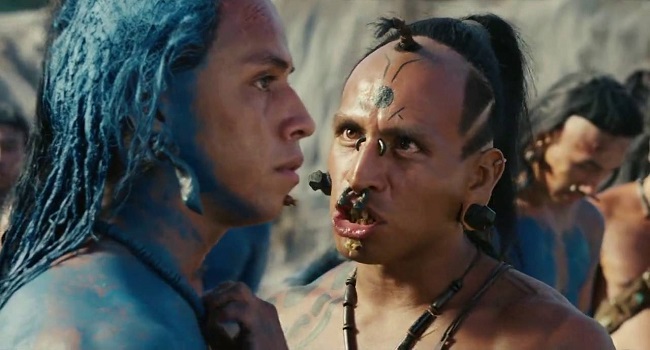
Directed by: Mel Gibson
Written by: Mel Gibson, Farhad Safinia
Cast: Rudy Youngblood, Raoul Trujillo, Mayra Sérbulo, Dalia Hernández, Ian Uriel, Gerardo Taracena, Rodolfo Palacios, Bernardo Ruiz Juarez, Ammel Rodrigo Mendoza, Ricardo Diaz Mendoza, Israel Contreras
I once wrote that one can’t be a critic and a filmmaker at the same time because the former is reactive while the latter is proactive. Yet, here I am contradicting myself, at least in a sense. While Apocalypto is already known, I desire to produce such short analyses simply out of respect. In his case it is because I believe that Mel Gibson, while already respected as a filmmaker, is actually still underrated. He is on the threshold of deserving the same reverence in film, both as art and entertainment, as Spielberg and Scorsese as great living directors. The masterpiece that is Apocalypto reminds us of his vision and reach.
Apocalypto, directed by Mel Gibson, produced by his Icon Productions along with Touchstone Pictures and released in 2006, is a film about revelation and revolution. The film follows a young tribesman named Jaguar Paw (Youngblood) as his idyllic life is uprooted by raiders who enslave his people and prepare him and others for sacrifice to Mayan deity Kukulkan. Jaguar Paw’s goal is to survive and make his way back to his expectant wife and their child who are trapped in a pit. Stripped of his tribe and with no home, he transforms from hunted to hunter as he claims his identity in life.
The word “apocalypse” comes from the Greek for revelation and indeed, as Jaguar Paw later gets an inkling, the film delivers on its titular promise. Through common use we associate the word with destruction, specifically with the destruction that comes with the reckoning with and realization of destiny, revolution and the divine. On an individual level Jaguar Paw experiences the revelation of identity without fear, while on a group level tribes and civilizations experience beginnings, endings and even new beginnings beyond. In Apocalypto, Gibson foreshadows the end of a culture and civilization at the same time as the beginning of new life and opportunity take root.
How the characters, as individuals and groups, deal with this in the film and, indeed, how we as an audience respond to them, given what we know of history, is what makes the film so special. A fact often skipped by history books that attack colonialism is that native peoples of lands newly discovered by Europeans also worshiped gods, waged war against one another and destroyed their environments. Apocalypto does not use this fact to justify colonialism, as such a focus is not of the film but of our informed reactions, rather it bookends the film with the inevitability of destiny based on human nature. The frames between reveal the value of that human nature and what makes it worthwhile, even in, especially in, the face of an uncertain future.
Controversial or not, an audience identifies with what is happening on the screen even though it is exotic, from another time, in a place inhabited by people about whom we know nothing and who speak a language we have never heard. Our connection with them is nevertheless possible due to our innate understanding of ourselves both as individual and as tribal animals and of course how the characters are presented on the screen.
Jaguar Paw’s tribe is full of life, energy, irony, hope, laughter, tenderness and insecurity. In other words, these people that are so far removed from any world we recognize are actually just like you and I. We are all insecure, which is why we form tribes. It’s the ancient survival instinct for safety in numbers. This insecurity reveals itself in the Mayan sacrifices to Kukulkan and in great warriors fearing a weak, helpless child in the jungle.
It is also revealed in Jaguar Paw’s fear of another tribe, a crucial beginning to his arc. His fear of the unknown, something with which an entire civilization must reckon at the end of the film, is changed into self-confidence on his own, without his tribe, as he fights his way back to his family, pursued by the raiders. At the end of the film, completely transformed, Jaguar Paw, upon seeing a threat even greater than all faced before, reacts not with fear or panic but with serenity as he heads back into the forest.
A worthy arc for an audience to behold, but it is not this transformation of a single figure that sustains our engagement. It is, rather, the way Gibson connects us to both protagonists and antagonists. Although the spoken language is alien to us, the inflection of their voices, their body language and their pragmatism all connect us to the characters in a way that dialogue, even in our own language, never could. You see, dialog, visual effects, sound (diegetic or nondiegetic) and even editing are all embellishments on the art form to which we refer to as “film” or “cinema” or “movies.” Gibson, through his directing, not only gives us the spice of an ancient language, he gives us the communication of real people as animals. From the testicular practical jokes of Jaguar Paw’s tribe to the terse, “he’s fucked,” analysis of a man bitten by a snake, we see in them our own nature.
Cinematically, the film is presented with a wild, primal energy, but without being overbearing. Costumes are brilliant yet organic and believable. Economic and religious classes of the Mayans are apparent. Scenes of decadence, corruption, sacrifice and striking natural phenomena intertwine to illustrate cinematic beauty even in decay. The fluid combination of brutality and unexpected simultaneous humor, often dark, is, to me, the Holy Grail of film, both as art and as entertainment. Clearly, what appears to be an action movie is so much more. The goal of a director is to avoid drawing attention to the layers and artifice of a film in any obvious way. The fact that all of these elements exist without acutely drawing attention to themselves is a testament to Gibson’s combination of vision and craftsmanship.
As we see in the characters ourselves so, too, do the characters, even environments, share traits and fates: Jaguar Paw’s tribe is obliterated, just as the Mayan civilization will fall, just as the Spanish Empire will dissipate. Environmental disaster comes not only from physical abuse of Mayan land but from corrupt leadership, social division and spiritual decay, things with which we are familiar today. Gibson, who is observed with a wary eye due to personal issues that are none of my or your business, never clearly indicates a Christian agenda.
The revelation that ends Apocalypto is something that continues sinking in after you’ve left the theater, gone home and found the occasional piece of popcorn in a crease in your trousers. [Spoiler alert for those who haven’t seen the film] In the immediacy of watching the film, still connected to the context of having experienced the rest of it, the arrival of the Conquistadors resonates not through the lens of religious conversion but through the lens of freedom and new life. You and I may know history but, to Jaguar Paw and his family who have just survived against incredible odds, their future in the forest supersedes whatever the strange light-skinned men in the boats may bring.
For now.



